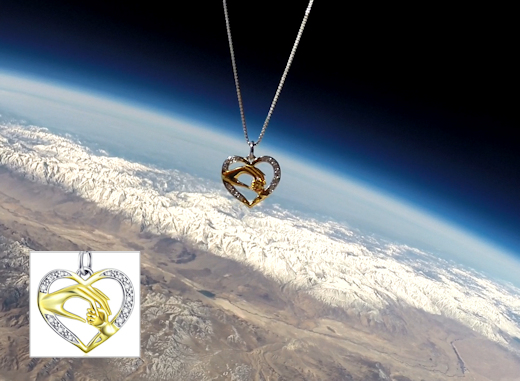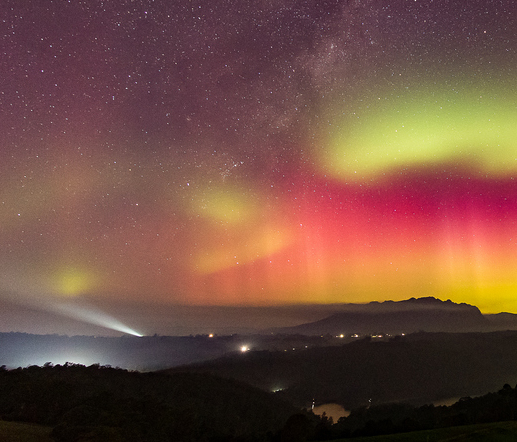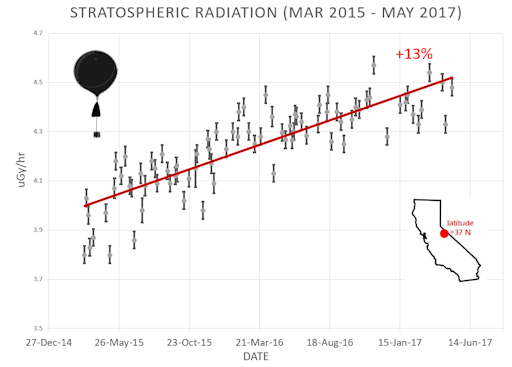 | | | Switch to: Europe, USA, New Zealand, Antarctica Credit: NOAA/Ovation  Planetary K-index Planetary K-index
Now: Kp= 3 quiet
24-hr max: Kp= 3 quiet
explanation | more data
Interplanetary Mag. Field
Btotal: 5.3 nT
Bz: 2.6 nT north
more data: ACE, DSCOVR
Updated: Today at 2347 UT  Coronal Holes: 21 Apr 18 Coronal Holes: 21 Apr 18 
Earth is inside a stream of solar wind flowing from the indicated coronal hole. Credit: SDO/AIA  Noctilucent Clouds Our connection with NASA's AIM spacecraft has been restored! New images from AIM show that the southern season for noctilucent clouds (NLCs) is underway. Come back to this spot every day to see AIM's "daily daisy," which reveals the dance of electric-blue NLCs around the Antarctic Circle.. Switch view: Ross Ice Shelf, Antarctic Peninsula, East Antarctica, Polar Updated at: 02-07-2018 17:55:05 Noctilucent Clouds Our connection with NASA's AIM spacecraft has been restored! New images from AIM show that the southern season for noctilucent clouds (NLCs) is underway. Come back to this spot every day to see AIM's "daily daisy," which reveals the dance of electric-blue NLCs around the Antarctic Circle.. Switch view: Ross Ice Shelf, Antarctic Peninsula, East Antarctica, Polar Updated at: 02-07-2018 17:55:05  SPACE WEATHER
NOAA Forecasts | | Updated at: 2018 Apr 21 2200 UTC FLARE | 0-24 hr | 24-48 hr | CLASS M | 01 % | 01 % | CLASS X | 01 % | 01 % |  Geomagnetic Storms: Geomagnetic Storms:
Probabilities for significant disturbances in Earth's magnetic field are given for three activity levels: active, minor storm, severe storm Updated at: 2018 Apr 21 2200 UTC Mid-latitudes | 0-24 hr | 24-48 hr | ACTIVE | 30 % | 10 % | MINOR | 10 % | 01 % | SEVERE | 01 % | 01 % | High latitudes | 0-24 hr | 24-48 hr | ACTIVE | 20 % | 20 % | MINOR | 30 % | 20 % | SEVERE | 35 % | 10 % | | | |  | | | | | | | | | | | Lights Over Lapland is excited to announce that our aurora webcam will be up and running 365 days per year! You can now enjoy watching the Midnight Sun and all of the other drama in the sky above Abisko National Park, Sweden here. | | | CHANCE OF MINOR STORMS: NOAA forecasters say there is a 55% chance of minor G1-class geomagnetic storms today, April 22nd, as Earth passes through the wake of an interplanetary shock wave. Arctic and Antarctic sky watchers should remain alert for auroras this weekend. Free: Aurora Alerts WEEKEND METEOR SHOWER: Earth is entering a stream of debris from Comet Thatcher, source of the annual Lyrid meteor shower. If forecasters are correct, the Lyrids will peak this weekend with as many as 20 meteors per hour. Programmer Ian Webster created this interactive visualization of Comet Thatcher's dusty debris stream: Occasionally Earth glides through an unusually dense clump of debris from Comet Thatcher, and this can cause a meteor outburst. For instance, one observer in the 19th century reportedly counted 167 Lyrids in 15 minutes. Another outburst in 1982 produced 90 Lyrids per hour. No such outburst is predicted for 2018—but then again, no outbursts were predicted on those previous occasions either. If you're up late, take a look. The best time to see these meteors is during the hours before sunrise on Sunday, April 22, when the shower's radiant is high in the sky. Dress warmly. Bring a reclining chair, or spread a thick blanket over a flat spot of ground. Lie down and look up. Meteors can appear in any part of the sky, although their trails will tend to point back toward the constellation Lyra. [sky map] MOTHER'S DAY IS JUST 3 WEEKS AWAY: On March 5, 2018, the students of Earth to Sky Calculus flew a cosmic ray balloon to the stratosphere, more than 94,000 feet above Earth's surface. This sterling silver Mother's Day pendant went along for the ride: 
You can have it for $129.95. The students are selling these pendants as a fund-raiser for their cosmic ray monitoring program. All proceeds support atmospheric radiation measurements and hands-on STEM education. Each pendant comes with a greeting card showing the jewelry in flight and telling the story of its journey to the stratosphere and back again. Mom-satisfaction guaranteed. Far Out Gifts: Earth to Sky Store
All proceeds support hands-on STEM education SOUTHERN LIGHTS: When an interplanetary shock wave hit Earth's magnetic field on April 19th, northern skies lit up with electric blue auroras. Southern skies lit up, too, but the palette was different. Peter Sayers sends this photo of red, yellow and green lights over Wilmot, Tasmania: 
"Overlooking Wilmot and the iconic Mt Roland, we saw bright naked eye auroras lasting an hour or two," says Sayers. "They were stunning. I used Lightroom to clean up some noise, but the color saturation in this image was not altered from the camera."
Similar colors were observed in New Zealand, while Antarctic observers witnessed almost pure green.
What's the difference? Northern Lights stimulated by the shock wave were dominated by ionized nitrogen molecules, which produce a blue glow at the upper limits of Earth's atmosphere. Southern Lights, on the other hand, were dominated by oxygen. Oxygen atoms glow red and green when excited by incoming particles from space. Oxygen and nitrogen are abundant in both hemispheres--so why they dominated in different places is anyone's guess. Consider it a beautiful mystery. Realtime Aurora Photo Gallery Realtime Space Weather Photo Gallery Every night, a network of NASA all-sky cameras scans the skies above the United States for meteoritic fireballs. Automated software maintained by NASA's Meteoroid Environment Office calculates their orbits, velocity, penetration depth in Earth's atmosphere and many other characteristics. Daily results are presented here on Spaceweather.com. On Apr. 20, 2018, the network reported 15 fireballs.
(15 sporadics)  In this diagram of the inner solar system, all of the fireball orbits intersect at a single point--Earth. The orbits are color-coded by velocity, from slow (red) to fast (blue). [Larger image] [movies] Potentially Hazardous Asteroids ( PHAs) are space rocks larger than approximately 100m that can come closer to Earth than 0.05 AU. None of the known PHAs is on a collision course with our planet, although astronomers are finding new ones all the time. On April 21, 2018 there were 1907 potentially hazardous asteroids.
 | Recent & Upcoming Earth-asteroid encounters: | Asteroid | Date(UT) | Miss Distance | Velocity (km/s) | Diameter (m) | | 2018 GC2 | 2018-Apr-17 | 9 LD | 4.9 | 15 | | 2018 GP4 | 2018-Apr-17 | 11.4 LD | 9.3 | 18 | | 2018 GK4 | 2018-Apr-17 | 5.9 LD | 10.8 | 20 | | 2018 HU | 2018-Apr-18 | 8 LD | 9.7 | 28 | | 2018 HS | 2018-Apr-20 | 5.1 LD | 18.9 | 35 | | 2018 GS3 | 2018-Apr-20 | 8.5 LD | 19.8 | 24 | | 2016 JP | 2018-Apr-20 | 12 LD | 12.7 | 214 | | 2018 HT | 2018-Apr-21 | 7.1 LD | 7.6 | 15 | | 2018 GR1 | 2018-Apr-21 | 18.3 LD | 16.4 | 53 | | 2018 HN | 2018-Apr-21 | 8 LD | 9.8 | 37 | | 2018 GG4 | 2018-Apr-23 | 9.8 LD | 14.9 | 20 | | 2012 XL16 | 2018-Apr-23 | 15.8 LD | 6.1 | 28 | | 2018 GH | 2018-Apr-25 | 14.6 LD | 10.7 | 89 | | 2018 HP | 2018-Apr-26 | 11.6 LD | 10.3 | 19 | | 2018 GH5 | 2018-Apr-27 | 12.2 LD | 12.7 | 32 | | 2018 GB2 | 2018-Apr-27 | 17.1 LD | 14.6 | 93 | | 2013 US3 | 2018-Apr-29 | 10.1 LD | 7.7 | 214 | | 2018 GO4 | 2018-Apr-29 | 11.8 LD | 8.6 | 46 | | 2018 GY1 | 2018-Apr-29 | 13.2 LD | 16.7 | 139 | | 2018 FV4 | 2018-Apr-29 | 17.7 LD | 6.5 | 59 | | 2002 JR100 | 2018-Apr-29 | 10.8 LD | 7.7 | 49 | | 1999 FN19 | 2018-May-07 | 9.7 LD | 5.7 | 118 | | 2016 JQ5 | 2018-May-08 | 6.3 LD | 10.4 | 9 | | 388945 | 2018-May-09 | 6.5 LD | 9 | 295 | | 2018 GR2 | 2018-May-11 | 13.4 LD | 9.8 | 109 | | 1999 LK1 | 2018-May-15 | 13.3 LD | 10 | 141 | | 2018 GL1 | 2018-May-18 | 14.3 LD | 5.2 | 67 | | 68347 | 2018-May-29 | 9.5 LD | 13.3 | 389 | | 2013 LE7 | 2018-May-31 | 17.8 LD | 1.7 | 12 | | 2018 EJ4 | 2018-Jun-10 | 5.6 LD | 6.2 | 195 | | 2015 DP155 | 2018-Jun-11 | 9 LD | 4.4 | 170 | Notes: LD means "Lunar Distance." 1 LD = 384,401 km, the distance between Earth and the Moon. 1 LD also equals 0.00256 AU. MAG is the visual magnitude of the asteroid on the date of closest approach. | | Cosmic Rays in the Atmosphere |
Readers, thank you for your patience while we continue to develop this new section of Spaceweather.com. We've been working to streamline our data reduction, allowing us to post results from balloon flights much more rapidly, and we have developed a new data product, shown here: 
This plot displays radiation measurements not only in the stratosphere, but also at aviation altitudes. Dose rates are expessed as multiples of sea level. For instance, we see that boarding a plane that flies at 25,000 feet exposes passengers to dose rates ~10x higher than sea level. At 40,000 feet, the multiplier is closer to 50x. These measurements are made by our usual cosmic ray payload as it passes through aviation altitudes en route to the stratosphere over California. What is this all about? Approximately once a week, Spaceweather.com and the students of Earth to Sky Calculus fly space weather balloons to the stratosphere over California. These balloons are equipped with radiation sensors that detect cosmic rays, a surprisingly "down to Earth" form of space weather. Cosmic rays can seed clouds, trigger lightning, and penetrate commercial airplanes. Furthermore, there are studies ( #1, #2, #3, #4) linking cosmic rays with cardiac arrhythmias and sudden cardiac death in the general population. Our latest measurements show that cosmic rays are intensifying, with an increase of more than 13% since 2015: 
Why are cosmic rays intensifying? The main reason is the sun. Solar storm clouds such as coronal mass ejections (CMEs) sweep aside cosmic rays when they pass by Earth. During Solar Maximum, CMEs are abundant and cosmic rays are held at bay. Now, however, the solar cycle is swinging toward Solar Minimum, allowing cosmic rays to return. Another reason could be the weakening of Earth's magnetic field, which helps protect us from deep-space radiation. The radiation sensors onboard our helium balloons detect X-rays and gamma-rays in the energy range 10 keV to 20 MeV. These energies span the range of medical X-ray machines and airport security scanners. The data points in the graph above correspond to the peak of the Reneger-Pfotzer maximum, which lies about 67,000 feet above central California. When cosmic rays crash into Earth's atmosphere, they produce a spray of secondary particles that is most intense at the entrance to the stratosphere. Physicists Eric Reneger and Georg Pfotzer discovered the maximum using balloons in the 1930s and it is what we are measuring today. | | The official U.S. government space weather bureau | | | The first place to look for information about sundogs, pillars, rainbows and related phenomena. | | | Researchers call it a "Hubble for the sun." SDO is the most advanced solar observatory ever. | | | 3D views of the sun from NASA's Solar and Terrestrial Relations Observatory | | | Realtime and archival images of the Sun from SOHO. | | | from the NOAA Space Environment Center | | | fun to read, but should be taken with a grain of salt! Forecasts looking ahead more than a few days are often wrong. | | | from the NOAA Space Environment Center | | | the underlying science of space weather |  | Reviews here can help you to pick up best memory foam mattresses. | | | These links help Spaceweather.com stay online. Thank you to our supporters! | | | | | | | | |  | |  |   | ©2017 Spaceweather.com. All rights reserved. This site is penned daily by Dr. Tony Phillips. | |

